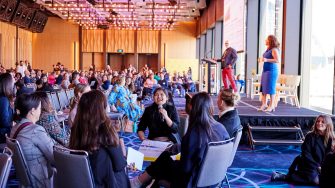“If we are looking for a roadmap to net zero, we need to transition away from fossil fuels, deal with coal, switch to renewable energy and electrify everything. When electrification is not possible, use other renewable energy sources,” Associate Professor Roberts said.
“We also have to conserve energy efficiency, stop deforestation, tackle agricultural emissions, get a well-staged carbon price, and when there's no other hope, use carbon capture and storage.”
"There is an enormous amount of work to be done and we need every country and every leader to go harder and faster in the race to net zero."
She urged those in the room to think about what they could do in their own work to reduce emissions and make a difference to the energy transition.
Putting sustainable leadership front and centre
The multitude of options provided insight into the real changes that can, and must, be made by governments and organisations. It also demonstrated the impact of collective effort to make a significant difference. And with the opportunity to lead the way in the global energy transition, there’s never been a more important time to make sustainable leadership a priority in Australia. Together, as leaders we can drive actionable commitment to climate change and safeguard our future.

